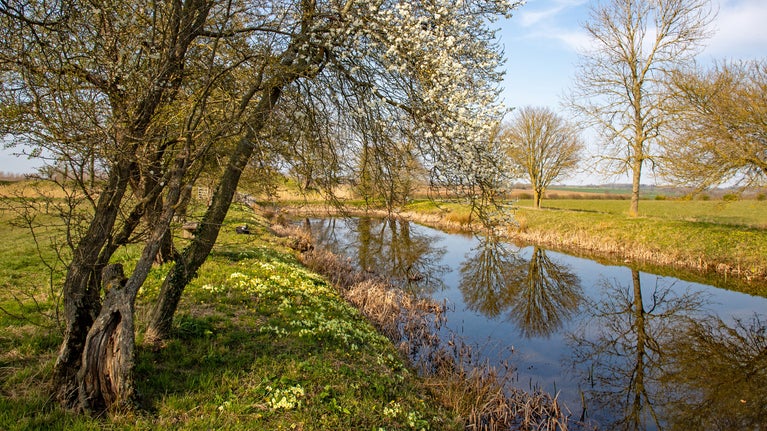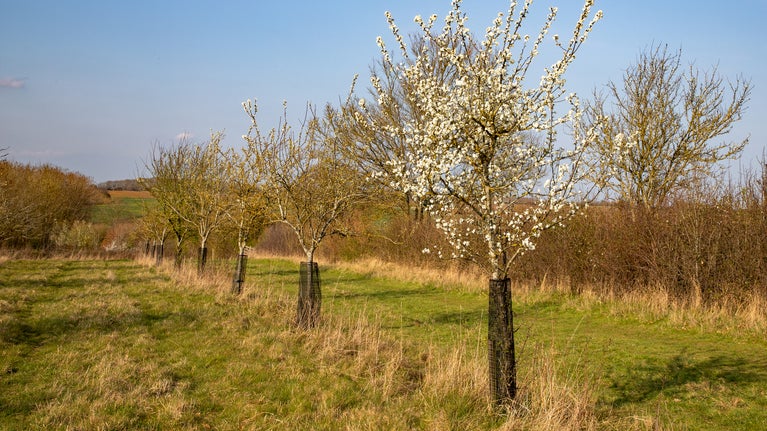Exploring the grounds at Lyveden

Walk through the Elizabethan garden design at Lyveden, find out more about Sir Thomas's life and ideas for his garden lodge. See if you can spot red kites flying above you and Purple Emperor butterflies in our woodland.
Things to see in the garden
Sir Thomas Tresham designed the garden at Lyveden as a journey of discovery. Starting in the valley bottom at Lyveden Manor House (the Old Bield), guests would have made the half-mile walk up through the garden, culminating on the ridge at the garden lodge (the New Bield).
Each element of the garden through which his guests would have passed was meticulously planned and designed and imbued with religious significance.
The orchard
Lyveden’s garden includes Sir Thomas Tresham’s orchard which was described as ‘one of the fairest orchards that is in England’ before its premature abandonment in 1605. Tresham’s pleasure garden was never completed after he died in 1605, but evidence suggests the orchard was planted.
Records show that Lady Tresham sold a large number of fruit trees to Robert Cecil, Secretary of State to King James I, in 1609, which were probably dug up from this orchard. The orchard you see today has been replanted by the National Trust and features over 300 trees of 19 different varieties planted in formal avenues.
The labyrinth
An aerial photograph from 1944 (re-discovered in 2003) shows clear traces of the original planting. Within the square created by the moats were 10 large concentric rings or borders – also described in a letter from Tresham of 1604 as 10 circular beds. These may have formed a labyrinth, with a single path winding to the centre.
Using the aerial photo as a guide a labyrinth has been cut into the long grass that lies between the moats. This is best viewed in the spring and early summer before the late summer cutting of the meadow. The labyrinth path is over a mile long.
Wander through the garden
Lyveden's garden is among the oldest in the country. Ascend the spiral mounds, stroll the banks of the moat, visit the orchard and take in the beauty of one of the country's finest surviving examples of Elizabethan garden design.
Explore the Lodge
A great opportunity to strip back the layers of a traditional country house, Lyveden is home to an unfinished garden lodge that lets you see the inner structure of what was intended to be a fully functioning country residence, but was never completed.
Make sure to bring suitable footwear
Much of Lyveden's grounds are accessed via grass paths. On wet days and outside of the summer months these paths have the potential to get muddy. It is recommended that you bring a pair of sturdy boots or wellies so you can make the most out of your visit.

Walking further afield
To enjoy more of the surrounding countryside why not walk the Lyveden Way? This approximately 10-mile route offers a true taste of Northamptonshire, including sheltered woodland, open fields, attractive wildlife and pretty villages.
Beginning at the Fermyn Woods Country Park which is home to many varieties of butterfly and fallow deer, the walk, which opened in 2005 as part of the 400th anniversary of Lyveden New Bield, passes Lyveden as part of the route.
Please take clear directions, an Ordnance Survey map, sturdy footwear, water and warm clothing with you on the Lyveden Way. Take care when crossing or walking on roads. You can download the Lyveden Way map below.
Seasonal delights at Lyveden
Lyveden is home to flourishes of colourful plant life and a multitude of wildlife, differing throughout the seasons. As you explore the gardens, woodland and orchard, keep an eye out for the different flora and fauna that call Lyveden home.
Winter highlights
Winter at Lyveden is when the site shines. With the trees bare the views of the garden lodge open up throughout the site. Frosty walks along the Lyveden Way or around the Lyveden site can end with a warming bowl of soup and hot drinks in the café watching the weather change outside the window.
Flora
See if you can spot any evergreen species of tree that are enduring the cold. Keep an eye out for the first snowdrop of spring, as well as the daffodils and hellebores in the cottage garden.
Fauna
Winter is when most wildlife will head for bed for a few months to await the return of spring. Whilst most animals won't be seen at this time of year, see if you can spot any tell-tale tracks in the snow. Make sure you look up to spot the Red Kites too which can regularly be seen catching the thermals above Lyveden, with their reddish-brown body and distinctive forked tail.
Wildlife highlights at Lyveden
Whatever the weather or season, Lyveden is a hub of nature. You're bound to spot something interesting when you visit.
Top tips for spotting wildlife
There's so much to see at any time of year, so make the most of this beautiful corner of the Warwickshire countryside and follow our top tips.
- Bring binoculars – you’ll often see young deer or birds if you keep your distance.
- Bring a magnifying glass – bugs, flowers and lichen are just as interesting as the big things. Be careful on sunny days, magnifying the sun’s rays can harm wildlife.
- Bring a camera or notebook and pencil - keep a record of what you see and research on the web or at your local library. Share your pictures on social media, we’d love to see them.
- Don't be seen – bright clothing can alert animals to your presence; even your shadow can disturb bugs and insects.
- Stay quiet and calm – waterproof clothing can be noisy, so you may need to keep still for a while before creatures are brave enough to show themselves.
- Scents and smells – some perfumes and suntan lotions can be strong, you may find an unscented type is better.
- Get comfy – bring a chair or rug, some visitors wait for hours to see a purple emperor butterfly.
Lyveden Way map
Your guide to walking the Lyveden way
Eating and drinking at Lyveden
The café in the Grade I-listed manor serves a range of hot and cold drinks, light meals, snacks and cakes to keep you refreshed during your visit. Take a seat indoors or enjoy your cuppa in the outdoor seating area.

Lyveden visitor map
A map of Lyvedens grounds.


